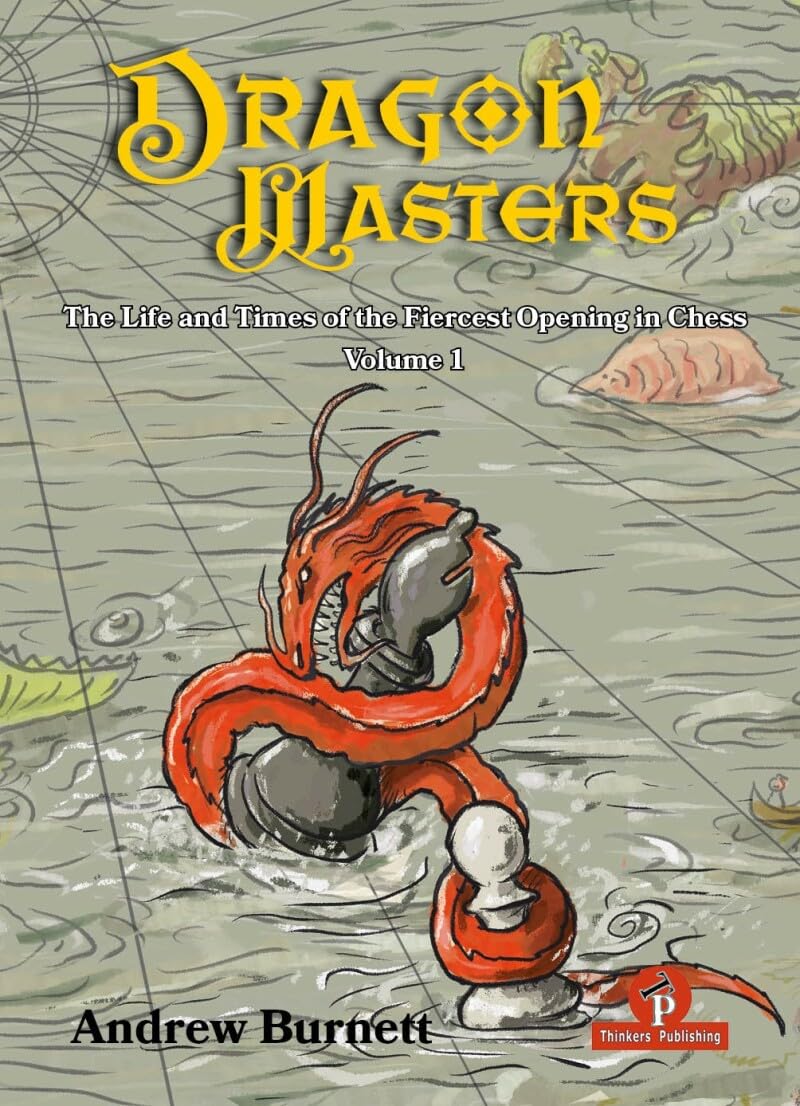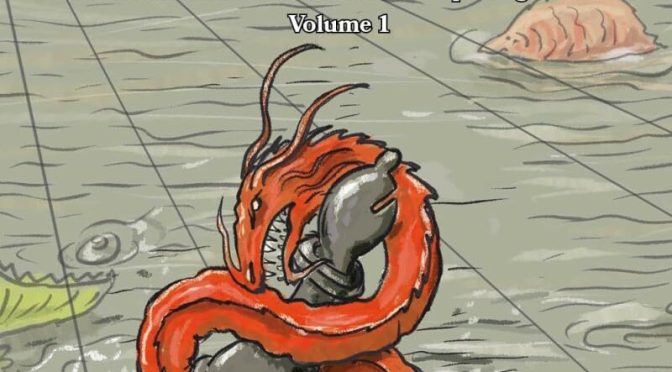From the Publisher, Thinkers Publishing:
DragonMasters volume 1 charts the history of the most exciting and dangerous opening known to chess – the Dragon Variation of the Sicilian Defense.
Unlike almost all other books on the Dragon, the focus is not purely on theoretical development. Instead, the author has combined the most historically important games, the famous players who chose to fight either side (sometimes both sides!) of the opening, and the most unexpected and interesting stories featuring the Dragon. World Champions, contenders of the crown, code-breakers, revolutionaries in every sense of the world – all feature in this remarkable and entirely unique look into the history of an opening variation. as the ancient may say: Here be Dragons!
About the Author:
Andrew Burnett is a Scottish FM who represented his country on several occasions. He is the author of cult classic Streetfighting Chess and his love of the Dragon opening stretches back to his teenage years when he was looking to escape 1.e4 e5! He is currently working on the second volume of DragonMasters.
This book is volume 1 of a labour of love devoted to the history, praxis, and famous players who have unleashed the fury of the Dragon Variation or fought to quench the fire of the wyvern.
Volume 1 covers the origin of the Dragon to 1973.
The front and back cover is an engaging, colourful picture.
This publication is not a theoretical treatise on the latest developments in the Sicilian Dragon, although it does give theoretical analyses in relation to historical variations and famous clashes with some references to modern variations and theory.
Many great players have had the Dragon in their regular repertoire, although the reviewer was surprised to find a game of Mikhail Tal’s on the black side, as I had the impression that Tal always preferred the white side. Perhaps the result of the game in this book influenced Tal’s choice: he got crushed. The reviewer will show this amusing brevity later.
The author, Andrew Burnett has a sub-variation in the Modern Variation 12.Kb1 named after him viz:
- e4 c5 2.Nf3 d6 3.d4 cxd4 4.Nxd4 Nf6 5.Nc3 g6 6.Be3 Bg7 7.f3 0-0 8.Qd2 Nc6 9.Bc4 Bd7 10.0-0-0 Rc8 11.Bb3 Ne5 12. Kb1! Nc4 13.Bxc4 Rxc4 14.g4! b5 15.b3! b4!?
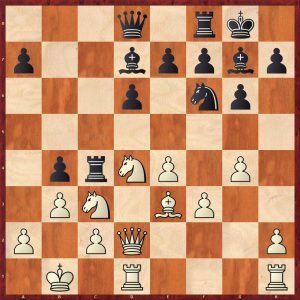
The work is divided into fifteen chapters:
Chapter 1 – In the beginning
Chapter 2 – Bird’s Folly
Chapter 3 – The World’s Finest Discover The Dragon
Chapter 4 – DragonMasters and DragonAmateurs
Chapter 5 – Hypermodernism and beyond
Chapter 6 – Botvinnik’s Trilogy
Chapter 7 – The War Years
Chapter 8 – The Post-War Years
Chapter 9 – When Giants take sides
Chapter 10 – Revolution in the 60s?
Chapter 11 – The Yugoslav Attack
Chapter 12 – DragonMasters and DragonWriters
Chapter 13 – Candidates and Contenders
Chapter 14 – The English Connection
Chapter 15 – The Dragon is Dead! Long Live the Dragon?
In the preface, Andrew Burnett shows a famous Dragon game which inspired the author to take up the Dragon; it also happens to be one of my favourites viz. Plaskett – Watson from Brighton 1983:
- e4 c5 2.Nf3 d6 3.d4 cxd4 4.Nxd4 Nf6 5.Nc3 g6 6.Be3 Bg7 7.f3 0-0 8.Qd2 Nc6 9.g4 Be6 10.O-O-O Nxd4 11.Bxd4 Qa5 12. a3 Rfc8 13.h4 Rab8 14.h5 b5 15.h6 b4! 16. hxg7 bxa3 17. Qh6 axb2+ 18.Kd2 reaching this super sharp scenario:
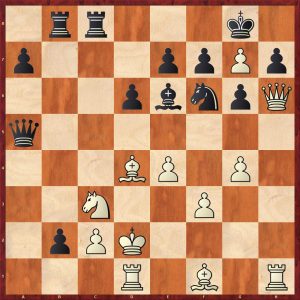
This position had been included in some theoretical treatises of the time with the +- symbol as White’s threat of Bxf6 and Qxh7# looks unstoppable. Jonathon Mestel had looked further and spotted 18…Bxg4! which muddies the waters. (As an aside, Stockfish 16 gives 18…Bxg4! as a draw and 18…Nh5! as a draw. This just shows the richness of chess and amazing hidden resources.)
19.Bxf6 Bh5! Simply blocking the h-file, giving Black time to continue with his attack. Jim Plaskett now goes wrong which is unsurprising as he must have been shocked by Black’s revelation.
20. Bd4? losing but only 20.Rxh5! equalises
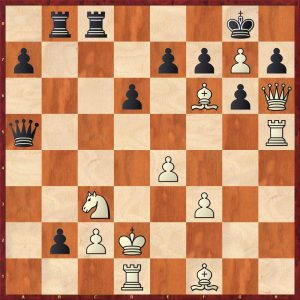
Best play after 20.Rxh5! leads to an unexpected repetition draw viz:
20…gxh5 21. Bh3 exf6 22. Bxc8 (22.Bf5? Qxc3+ 23.Ke2 Qxc2!+ 24. Rd2 Qc4+ 25.Kf2 Qc5+ 26. Kg2 Qxf5 27. exf5 b1=Q winning for Black). 22…Rxc8 23.Qxf6 Qb4! 24.Rb1 a5 threatening a4-a3-a2 25.Kd3 (threatening Nd5) Qc4+ 26.Kd2 Qb4 27.Kd3 with a draw!
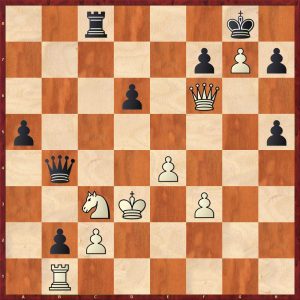
As is so often the case in these double edged lines, the game fizzles out to an exciting draw. Brilliant stuff.
The game continuation was a massacre 20…e5! 21.Rxh5 gxh5 22. Qg5 Qb4 23.Bd3 Qxd4 24. Nd5 Qf2+ 25. Be2 Rxc2+ 26.Kxc2 Qxe2+ 27.Kc3 Qxf3+ 28.Kc4 Qb3#
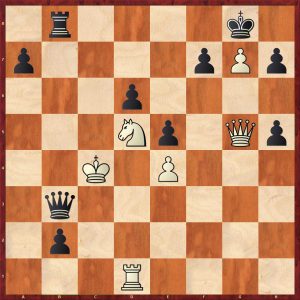
Chapter 1 introduces the first games featuring a Sicilian with a black, kingside fianchetto.
The reviewer was under the false impression that Louis Paulsen was the first to play a Sicilian with a kingside fianchetto. Although Paulsen did play some Dragons including beating Steinitz in London in 1862, it was Marmaduke Wyvill who played the first recorded “high-level Dragon” in 1851 at the celebrated London International tournament. We all remember Adolf Anderssen winning that tournament but do we recall whom he defeated in the final? It was Wyvill.
Some of these first Sicilian fianchetto games don’t resemble the modern Sicilian Dragon move orders and are full of basic strategic mistakes but do give insights into the development of the variation and the Sicilian defence in general. Game 3 of the book demonstrates Paulsen’s win over Steinitz with an hyper accelerated Dragon although he was lost out of the opening!
Louis Paulsen was one of the great pioneers of the Sicilian Defence, not just developing the variation named after him.
Chapter 2 concentrates on Henry Bird’s contribution to early Dragon Praxis.
He was the first player to play the modern Dragon move order:
1.e4 c5 2.Nf3 d6 3.d4 cxd4 4.Nxd4 Nf6 5.Nc3 g6
As the author points out, his score with the Dragon was 16 losses, 10 wins and 9 draws which is not brilliant, but taking into account he was playing against the world’s best, it is a respectable Dragon legacy.
Game 7 shows a titanic struggle with Joseph Blackburne. This is the position after the opening:
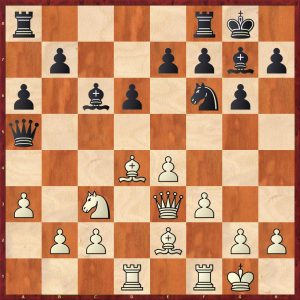
This could be a modern game with white playing a fairly inept Classical Variation, but making sensible developing moves leaving the main struggle to the middlegame. Bird played the somewhat dubious 14…Qh5?! (better is the natural 14…Nd7 which is clearly equal). Blackburne responded with the impatient move 15.Bxf6 (Simply 15.Qf2 or 15.Rd3 leaves white with a slightly more comfortable position) 15…Bxf5 16.Nd5 Qe5 is equal. The players fought out a exciting draw to move 77. Buy the book to the see the game.
Chapter 3 introduces some of the first games with top players riding the Dragon such as Emmanuel Lasker.
This chapter features some greats such as Tarrasch, Pillsbury and Emmanuel Lasker playing the Dragon at the end of the 19th century and the beginning of the 20th century. The game below shows a typical Dragon trap.
Brody – Pillsbury Paris 1900
1.e4 c5 2.Nf3 Nc6 3.Nc3 Nf6 4.d4 cxd4 5.Nxd4 d6 6.Be2 g6 7.Be3 Bg7 8.0-0 Bd7 9. h3 Qa5
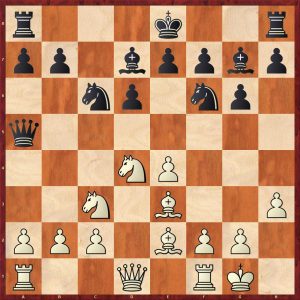
White now played a natural looking move that loses 10.Qd2?? Ne4! 11.Nc6 Qxc3! (Easy to overlook) 12.Qxc3 Nxc3 13. bxc3 Bxc6 (Black is completely winning, a pawn up with a much better pawn structure)
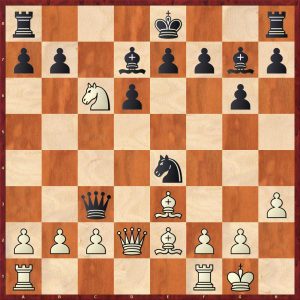
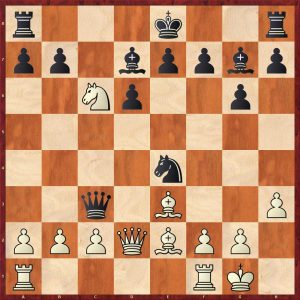
Chapter 4 shows some early games with masters v amateurs.
The first game in this chapter is famous tussle Lasker – Napier at Cambridge Springs 1904. This game is an extremely tactical queenless middlegame and is well worth a look.
Another game covered is a loss by Lasker to a modern idea of an exchange sacrifice on c3 in a simultaneous display. This idea had been seen before but this version is so thematic, it must be shown:
Emmanuel Lasker – Donald MacKay Hampstead 1908
1.e4 c5 2.Nf3 Nc6 3.Nc3 g6 4.d4 cxd4 5.Nxd4 Bg7 6.Be3 d6 7.Be2 Nf6 8.h3 0-0 9.0-0 Bd7 10.f4 a6 11.g4 Rc8 12.f5 Ne5 13.g5
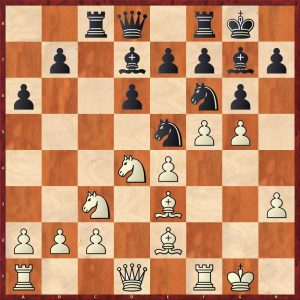
13…Rxc3! (Winning as White’s position falls apart) 14. bxc3 Nxe4 15.Bd3 Nxc3 16.Qe1 Nxd3 17.Qd3 Nc5 18.f6!? (A desperate try)
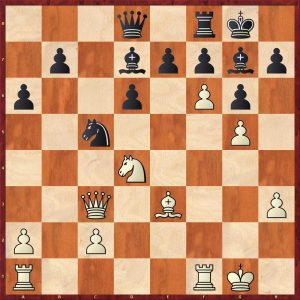
18…exf6 19.gxf6 Ne4 (19…Bxf6 wins as well) and Black won on move 34.
Chapter 5 features the introduction of two major Dragon lines.
They are 10…Qc8 in the Classical Variation and the DragonDorf played by another great Sicilian pioneer Miguel Najdorf.
The first variation is shown with a famous game Reti -Tartakower
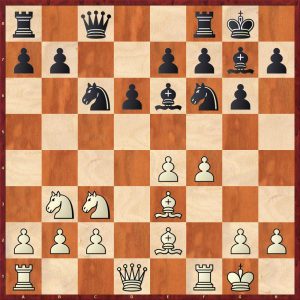
The game continued 11.h3 Ne8 ?! (A modern master would shudder at this move, the natural 11…Rd8 is better, Reti won a good positional game)
The game Reissner – Najdorf from Warsaw 1934 introduces the Dragadorf which Simon Williams reintroduced many decades later.
The game began 1.e4 c5 2.Nf3 d6 3.d4 cxd4 4.Nxd4 Nf6 5.Nc3 g6 6.Be3 Bg7 7.f3 0-0 8.Qd2 a6? (Black cannot play this slowly after castling, if Black wishes to play this way, he must not castle early).
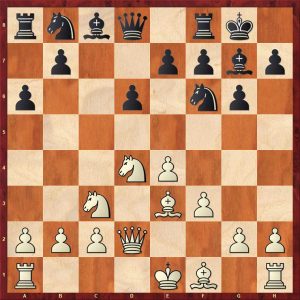
Stockfish already gives White a big advantage. Najdorf did win this game as White did not play incisively enough. See the book to look at these two interesting games.
Chapter 6 features the famous Alekhine-Botvinnik melee from Nottingham 1936 resulting in an exciting short draw.
1.e4 c5 2.Nf3 d6 3.d4 cxd4 4.Nxd4 Nf6 5.Nc3 g6 6.Be2 Bg7 7.Be3 Nc6 8.Nb3 0-0 9.f4 Be6 10.g4!? (The Rabinovich Attack)
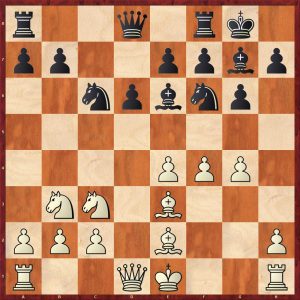
10…d5!? (The modern preference is for 10…Rc8 when Black may already be better) 11.f5 Bc8 12.exd5 Nb4
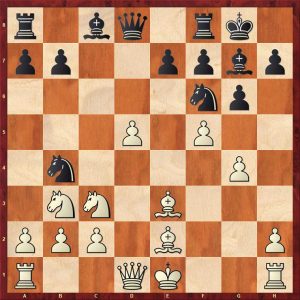
A critical position 13.d6!? (13.Bf3! is much stronger leading to a significant White advantage) 13…Qxd6 (leading to a forced perpetual) 14. Bc5 Qf4! 15.Rf1 Qxh2 16.Bxb4 Nxg4 17.Bxg4 Qg3+ 18. Rf2 (Any winning attempt is suicidal) Qg1+ 19.Rf1 Qg3+ 20.Rf2 Qg1+ Draw agreed
Chapter 7 introduces the Levenfish Variation with Mikhail Tal falling victim.
Game 31 showcases the game that introduced the Levenfish Variation at the highest level: Levenfish – Rabinovich Leningrad 1939. The author’s commentary on this game is full of excellent analysis showing many of the traps in the Levenfish and some brilliant white victories. Two of the greatest attacking players have games in this variation including a crushing win by Nezhmetdinov and a crushing loss for Tal. First the Tal miniature:
Janis Klavins – Mikhail Tal Riga 1954
1.e4 c5 2.Nf3 d6 3.d4 cxd4 4.Nxd4 Nf6 5.Nc3 g6 6.f4
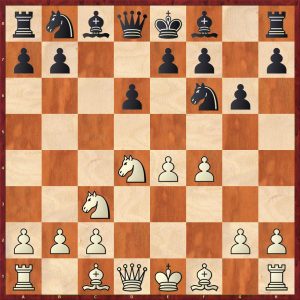
6…Nc6! (6…Bg7!? is dangerous for Black, but just about playable with care, but 6…Nc6 equalises easily, so why play an inferior risky move?)
7.Nxc6 bxc6 8. e5 (This looks dangerous but is a paper tiger) Nd7! 9.exd6 exd6 10.Be3
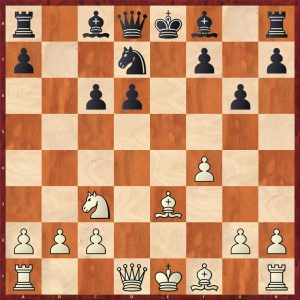
10…Qe7?! (10…Be7 is slightly better for black already, the pawn on f4 weakens White’s position) 11.Qd4! Nf6?! (11…Bg7 is hardly better: 12.Qxg7 Qxe3+ 13.Be2 Rf8 14.Rf1 Nb6 15.Rd1 is better for white despite white’s king on e1 as Black is behind in development and has a weaker pawn structure with black squared weaknesses.) 12.0-0-0 Bg7
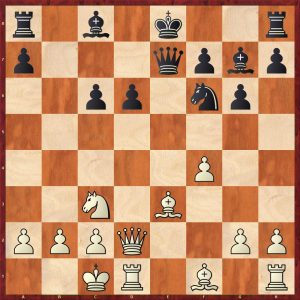
White has a significant lead in development which he exploits ruthlessly in the style of his opponent:
13.Qxd6! (sacrificing a piece with check) Qxe3+ 14.Kb1 Bd7? (14…Qb6! makes it harder for White but his attack is just too strong) 15.Bb5! (A classic clearance: 15…cxb5 16.Rhe1 wins the queen and although Black has a rook and two bishops for the queen and pawn, his lack of development is fatal) 15…Qb6 16.Rhe1+ Kd8 17.Bxc6 Rb8 (threatening mate but too late) 18. Qe7+ Kc7 19.Rxd7+ Kc8
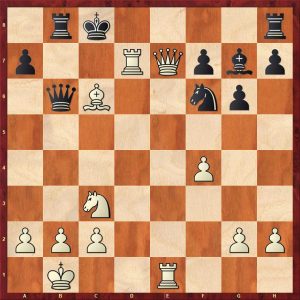
20.Bb5 (20.Nb5! is quicker mating in four moves, Klavins chooses a prosaic win going into a trivially won endgame) Rb7 21.Rxb7 Qxb7 22.Qxb7+ 1-0
Now the Nezhmetdinov game:
1.e4 c5 2.Nf3 d6 3.d4 cxd4 4.Nxd4 Nf6 5.Nc3 g6 6.f4 Bg7?! (Risky) 7.e5! dxe5? (The only decent move here is the surprising 7…Nh5 with the idea 8.g4? Nxf4 9.Bxf4 dxe5 regaining the piece with interest, better for White is 8.Bb5+ Bd7 9.Qe2! with an edge as Black still has to solve the problem of the h5 knight, 9.e6!? looks good but 9…fxe6 10.Nxe6 Bxc3+ 11.bxc3 Qc8! is a mess but dynamically equal) 8.fxe5 (This is a very dangerous position for the unwary)
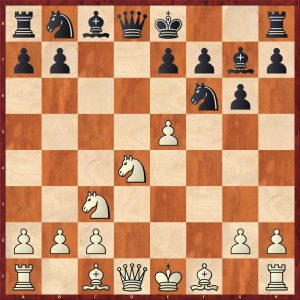
8…Nd5? (8…Ng4?? 9.Bb5+ wins 9…Bd7 10.Qxg4 wins a piece or 9…Kf8 10.Ne6+ wins the queen. 8…Nfd7 is relatively best 9.e6! Ne5! 10.exf7+ gives a White a pleasant edge but Black can fight) 9.Bb5+ Kf8 10. 0-0 (Black is totally lost) Bxe5 (accelerating the inevitable defeat, and allowing an attractive finish, 10…Nc6 lasts longer) 11.Bh6+ Kg8 12. Nxd5 Qxd5 13.Nf5! Qc5+ 14.Be3 Qc7 15.Nh6+ 1-0
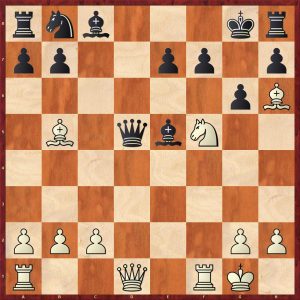
Chapter 8 features a famous victory by a British player, William Winter over David Bronstein in the England – USSR radio match in 1946.
1.e4 c5 2.Nf3 d6 3.d4 cxd4 4.Nxd4 Nf6 5.Nc3 g6 6.Be3 Bg7 7.f3 Nc6 8.Qd2 0-0 9.Nb3!? (Not the most challenging line) 9…Be6 10.Nd5 Bxe6 (Stockfish also likes 10…Rc8 with both moves giving Black a slight edge, but removing the pesky knight now is understandable) 11.exd5 Ne5
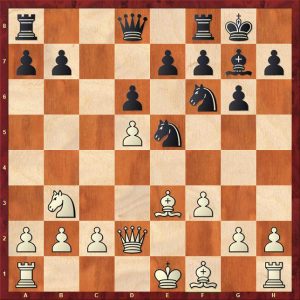
12. Be2? (12.0-0-0 is better but Black is at least equal) Qc7 13.0-0 (13…a5! is also good but the move played is an obvious thematic Sicilian move) Nc4 14.Bxc4 Qxc4 15. Rad1?! (The wrong rook, White needs the queen’s rook on the queenside for defence, showing how badly the game is going) 15…Rfc8! 16.Rf2 Nd7 (16…a5! increases Black’s advantage to decisive proportions) 17.Bg5!? (Trying to mix things up, but 17.c3 is better, then Black has 17…a5 with a typical Sicilian initiative and advantage) 17..Bxb2 18.Bxe7 Nb6? (Bronstein’s gamble with Bg5 has paid off as Black goes wrong, much better is 18…Bc3! 19.Qd3 Qb4 maintains a big Black advantage) 19.Bxd6 Rd8
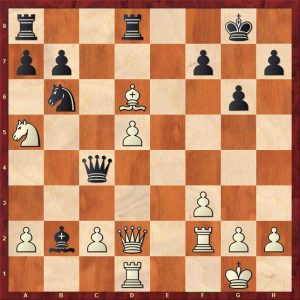
20. Na5?? (A horrible move losing the game, 20.Qb4 or 20.Qf4 holds the balance) 20…Qa6! 21.Qf4 Rxd6 22.c4 Bg7 23.Rfd2 Bh6 24. Rd3 Rad8 25.a4 Bf6 26.Qb5 Qxb5 27.axb5 R6d7 0-1
Chapter 9 introduces some giants into the mix with players such as the great Soviet theoretician Efim Geller who played the Dragon with both colours, and the great Bobby Fischer who was a veritable St George. Fischer famously lost against Cesar Munoz, a Ecuadorean National Master: this game is definitely worth a look.
This chapter also includes the famous Fischer – Larsen clash from Portoroz 1958. The game is in a line that has become topical recently:
1.e4 c5 2.Nf3 d6 3.d4 cxd4 4.Nxd4 Nf6 5.Nc3 g6 6.Be3 Bg7 7.f3 0-0 8.Qd2 Nc6 9.Bc4 Nxd4 10.Bxd4 Be6 11.Bb3 Qa5 12.0-0-0 b5 13.Kb1 b4 14.Nd5 14…Bxd5
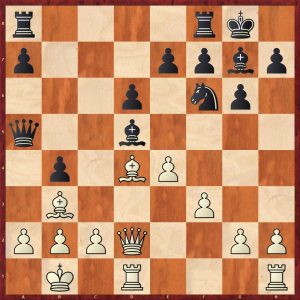
15.Bxd5 (Not best, better is15.exd5! Qb5 16.Rhe1 a5 17.Qe2! Tal, M-Larsen, B Zürich 1959)
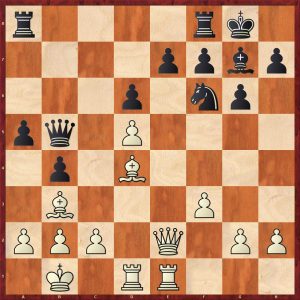
This position used to be thought to be slightly better for White with the bishop pair and pressure along the e-file. Modern engines dispute this and reckon Black is more or less equal viz:
17… Qxe2 18.Rxe2 a4 19.Bc4 Rfc8 20.b3 (20Bb5?! Ra5=) Rc7= 21.Bb5 axb3 22.cxb3 Ra5 23.Bc4 Rb7 = (Stockfish gives White a tiny advantage)
Now back to the main game.
15…Rac8?! (Much better is 15…Nxd5 16.Bxg7 Nc3!!+ 17.Bxc3 bxc3 18.Qxc3 Qxc3 19.bxc3 Rfc8 20.Rd3 Rc5 =, or 17.bxc3 Rab8! 18.cxb4 Qxb4+ 19.Qxb4 Rxb4+ 20.Bb2 Rfb8=)
16.Bb3! and Fischer won a great game.
Chapter 10 introduces the famous Soltis Variation.
It may not be widely known, but in 1963 Heikki Westerinen introduced the Dragon Soltis Variation to the world, 8 years before Andrew Soltis popularised the variation named after him. This is the stem position:
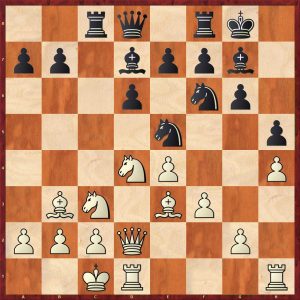
Westerinen played this line against Bent Larsen, who was one of the protagonists who played the Dragon with both colours. He lost the game, but his opening and early middlegame were fine as he achieved a winning position by move 20: he was outplayed later by a world class player. Buy the book to see analysis of this ground breaking game.
Chapter 11 introduces Geller on the Black side and Anatoly Karpov as a chief Dragon slayer. His game against Gik in the Moscow University championship in 1968 is one of Karpov’s best games.
1.e4 c5 2.Nf3 d6 3.d4 cxd4 4.Nxd4 Nf6 5.Nc3 g6 6.Be3 Bg7 7.f3 0-0 8.Bc4 Nc6 9.Qd2 Qa5 10.0-0-0 Bd7 11.h4 Ne5 12.Bb3 Rfc8 13.h5 Nxh5 14.Bh6 Bxh6 15.Qxh6 Rxc3 16.bxc3
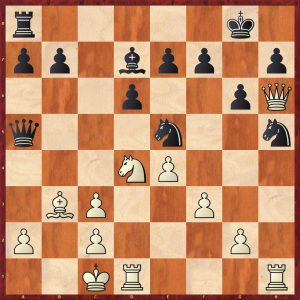
In this position below Gik made a fatal mistake: 16…Qxc3 no doubt expecting 17.Kb1, so 17.Ne2 came as a rude awakening gaining a crucial tempo, both 16…Nf6 and 16…Rc8 equalise comfortably.
The book analyses this theoretical scuffle in detail.
Chapter 12 is devoted mainly to famous Dragon writers: David Levy and Andrew Soltis.
David Levy, the Scottish IM famously wrote two editions of the Batsford books The Sicilian Dragon. Here Levy faces the former World Champion, Boris Spassky who is in devastating form:
1.e4 c5 2.Nf3 d6 3.d4 cxd4 4.Nxd4 Nf6 5.Nc3 g6 6.Be3 Bg7 7.f3 Nc6 8.Qd2 0-0 9.Bc4 Bd7 10.0-0-0 Qb8?! (A trendy line at the time, which is almost certainly unsound, Stockfish does not rate it.)
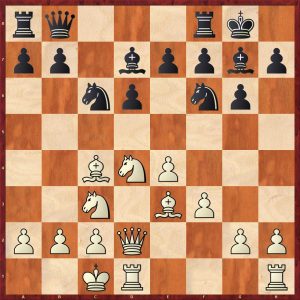
11.h4! a5? (This is a horrible move, it loses quickly, Stockfish recommends 11..Ne5 12.Bb3 h5 trying to slow down the attack in Soltis style, but Black’s misplaced queen renders this fruitless) 12.Bh6!? (Not the very best, the simple 12.h5 is even stronger winning quickly) 12…Nxe4? (Black pushes his luck with a flawed combination, better was 12…Nxd4 13.h5! Be6 14.Bxg7 Kxg7 14.Qxd4 with a big plus for White) 13. Nxe4 Bxd4 14.h5! (With a huge winning attack)
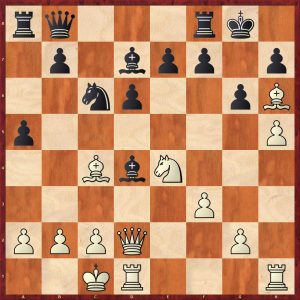
14…d5 (Desperation, trying to get the queen into the defence) 15.Bxd5 Qxe5 16.Bxf8! (Simple and effective) 16…Qxd5 17.Qh6! Nb4 18.Rxd4! (Removing the last defender) Qxd4 19.Bxe7 1-0
An opening experiment crushed by an attacking great!
Chapter 13 is mainly devoted to two fascinating clashes between Efim Geller and Viktor Korchnoi in their Candidates match in 1971 in Moscow. It also reintroduces Anatoly Karpov who is undoubtedly one of the greatest Dragon slayers, shown in action in a famous tussle with Juergen Dueball at Skopje in 1972. It was Karpov’s endgame skill that won him that game.
The first Geller – Korchnoi shows the good old exchange sacrifice on c3 in all its glory.
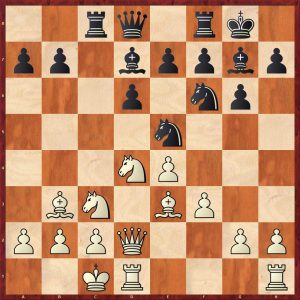
White played the poor 12.Bh6?! provoking Black. 12…Bxh6! 13.Qxh6 Rxc3! 14.bxc3 a5! (14…Qc7 is fine as well)
Black is equal here and has a position that is easier and more fun to play. The game was eventually drawn, but Black achieved a winning game but threw it away in mutual time trouble.
Chapter 14 introduces one of the great Dragon specialists, the late and great Tony Miles.
Here is a exciting scrap with another future GM, Michael Stean.
Michael Stean – Tony Miles Hastings 73/74
1.e4 c5 2.Nf3 d6 3.d4 cxd4 4.Nxd4 Nf6 5.Nc3 g6 6.Be3 Bg7 7.f3 0-0 8.Bc4 Nc6 9.Qd2 Bd7 10.h4 h5 11.0-0-0 Rc8 12.Bb3 Ne5 13.Kb1 Nc4 14.Bxc4 Rxc4 15.Nde2 Qc7 !? (An attempt to avoid the main line theory, 15…b5 is the main line which equalises comfortably as played by Kasparov against Anand 16.Bh6 Qa5 =)
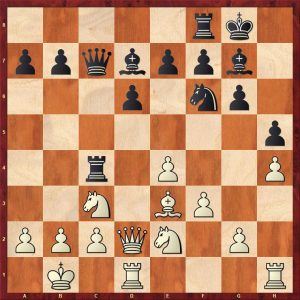
16.Bh6 Be6 17.Bxg7 Kxg7 18.Nf4 Qa5 (This position is equal, but Stean comes up with a faulty plan) 19.Nxe6+ (19.Nce2 is equal) fxe6 20.Rh3?! (20.Ne2 is still equal) Rfc8 21.Rg3?
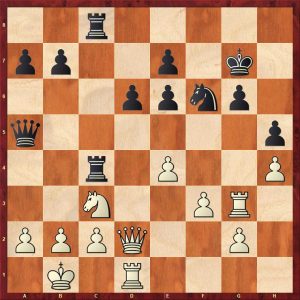
Rxc3! (Now Black is better) 22.bxc3 Rc6 23.Rg5 e5! (Cutting the rook off)
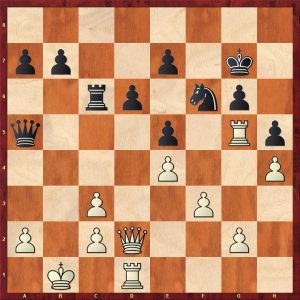
Now Black is slightly better, somehow Miles contrived to lose this game.
Chapter 15 is devoted to one of the most famous gladiatorial contests in the Sicilian Dragon: Anatoly Karpov v Viktor Korchnoi Moscow 1974 game 2 of the Candidates final. The winner was to play Bobby Fischer.
1.e4 c5 2.Nf3 d6 3.d4 cxd4 4.Nxd4 Nf6 5.Nc3 g6 6.Be3 Bg7 7.f3 Nc6 8.Qd2 0-0 9.Bc4 Bd7 10.h4 Rc8 11.Bb3 Ne5 12.0-0-0 Nc4 13.Bxc4 Rxc4 14.h5 Nxh5 15.g4 Nf6 16.Nde2 !?
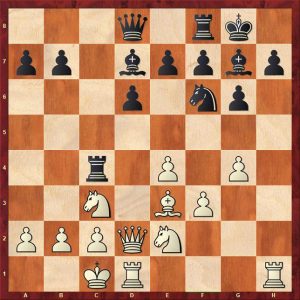
At the time, the position before 16.Nde2 was a topical Dragon tabiya. Korchnoi played the natural reply which is already a mistake.
16…Qa5 (16…Re8 is much better and about equal) 17.Bh6 Bxh6 (17…Bh8 18.Bxf8 Kxf8 19.Qe3 is clearly better for White) 18.Qxh6 Rfc8 19.Rd3 R4c5? (The final mistake, 19…Be6 20. 20.g5 Nxh5 21. Nf4 Qe5 22.Nxh5 gxh5 23. Qxh5 Qg7 24.f4 with a clear advantage to White) 20.g5! (Winning) Rxg5 21.Rd5! Rxd5 22.Nxd5 Re8 23.Nef4 Bc6 24.e5!+- Bxd5 25.exf6 exf6 26.Qxh7+ Kf8 27.Qh8+ 1-0 (27… Ke7 28.Nxd5+ Qxd5 29.Re1+)
It is quite possible that the whole game was prepared analysis.
This game really knocked the Dragon for six, but the Dragoneers soon came up with an antidote 16…Re8.
In summary, this is a well thought out book and an enjoyable read with plenty of exciting, fighting chess. Although it is a history of the Dragon, that story is really a microcosm of the development of modern chess from 1850 onwards.
FM Richard Webb, Basingstoke, Hampshire, 1st April 2024

Book Details :
- Hardcover : 385 pages
- Publisher:Thinkers Publishing; 1st edition (5 Mar. 2024)
- Language: English
- ISBN-10: 9464201959
- ISBN-13: 978-9464201956
- Product Dimensions: 17.78 x 3.18 x 24.77 cm
Official web site of Thinkers Publishing
